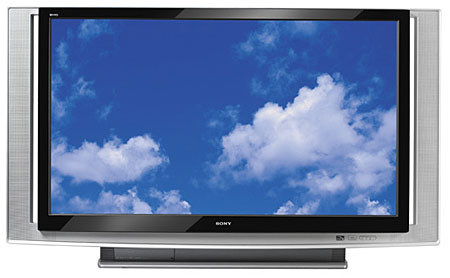Sony KDS-R70XBR2 1920x1080 SXRD RPTV

That set wasn't aimed at conventional retail channels and wasn't on the market very long. Attempts to deliver a really big image in a one-piece TV continue to this day. But these products are expensive, cumbersome, and not right for everyone.
For those who want a really BIG screen experience, the typical route to this goal is a front projector and separate screen. But if this solution just won't work for you or your room, what do you do?
Several companies are now ready with the answer—rear projection sets with screens ranging from 70- to 72-inches (diag.). That isn't huge by front projection standards, but for an RPTV, it sure is big. For the average living or family room, that's really BIG. Swallow the room big. Decorator heart attack big. Divorce papers big.
Sony's rear projection KDS-R70XBR2 is a prime example. As Sony's flagship SXRD set, it isn't cheap at $5,999. You can buy a good projector—say Sony's own VPL-VW50 "Pearl" —and a decent screen for that price. But if an integrated solution is better for you, this set is worth every penny.
Description
This stand-mountable set (a suitable stand is available as an option) isn't exactly svelte. At over two feet deep, it's more like your grandfather's CRT RPTV than those hang on the wall flat panel designs that are so popular today. (If a 70" flat panel is a must, bring deep pockets- Sony's new 70" LCD costs $33,000!).
With its removable speakers in place, this 70-inch XBR2 set is just over six feet wide. Without them, which is how I reviewed the set, it's a "diminutive" 67 inches. The width of the screen area itself is about 60 inches, which is smallish by front projection standards but still a good-sized screen in most rooms.
As mentioned, this set isn't cheap. But there are some technologies that separate it from the competition. It uses Sony's well-established SXRD technology, featuring a full three-chip design with a native 1920x1080 pixel count. The 1080p DLP RPTVs currently on the market are single-chip designs using a color wheel and some sleight of hand to use a 960x1080 chip to put 1920x1080 pixels on screen. Also, the KDS-R70XBR2 (hereafter referred to simply as the R70 to delay the onset of carpal tunnel syndrome) includes every feature known to Sony.
DRC (Digital Reality Creation)-MF V2.5 is the latest version of Sony's video processing engine. It offers several separate modes and adjustments. More on that later.
Advanced Iris is Sony's name for its various iris settings, including two automatic and two dynamic modes. CineMotion is a film mode that applies inverse 3/2 pulldown for film-based sources. Twin View is split screen for watching two programs at the same time (though only one can come from the set's single onboard SDTV/DTV/HDTV tuner). The set is also CableCARD-ready.
 There are more than enough inputs for most requirements (see "Specifications"), including three HDMI jacks. They are not HDMI 1.3, however—a point we'll probably have to start making clear since the first HDMI 1.3-ready sets are trickling into the market.
There are more than enough inputs for most requirements (see "Specifications"), including three HDMI jacks. They are not HDMI 1.3, however—a point we'll probably have to start making clear since the first HDMI 1.3-ready sets are trickling into the market.
The R70 will accept HD signals up to 1080i over component and 1080p over HDMI. It will also accept both 1080p/60 and 1080p/24. But it converts incoming 24fps sources to 60fps, adding 3/2 pulldown. This is a limitation common to many displays, and it essentially eliminates any advantage that might be gained from using the 1080p/24 output of a high-definition disc player.
You'll also find all the standard features you might expect, including Parental Control, Aspect Ratio (including Wide Zoom, one of those uneven stretch modes for taffy pulling a 4:3 source to fill the 16:9 screen, which actually works better here than most), separate coaxial and cable RF inputs, and the TV Guide On Screen program guide, which takes the manual seven pages to explain.
You'll do most of your communicating with the set via the remote. Apart from the lack of backlighting, it's a good one. While some of the buttons are a little small, I had no other complaints. It can control three other components as well as the television, and is programmable by means of the usual codes. But it's not a learning remote. If you don't have the codes for a given piece of gear, you'll have to rely on the dedicated remote for the product.
The on-screen menu layout is similar to the system Sony has been using for some time. I'd like to say that I'm a fan of the way it's organized, but I'm not. I often found myself jumping into the wrong menu or menu level when using the joystick control, or even exiting the menu by accident. The joystick control was very precise in its operation, but the direction I needed to push wasn't always intuitive. I admit, however, that I've been maneuvering around six different display remotes over the past few weeks, so none of them have yet become completely intuitive.
Two ergonomic nuisances wouldn't go away. First, there is no direct input selection—an all too common omission. Second, it takes too many steps to reach some of the adjustments. For example, it takes a minimum of six button pushes to get to the point where you can adjust the Picture control (Sony's designation for Contrast). Some competing sets offer direct access buttons on the remote for some of the more commonly used controls.
- Log in or register to post comments






























































